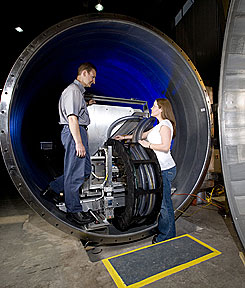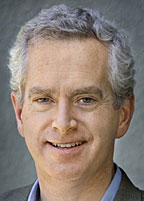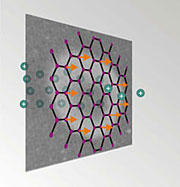| Research
|
"Climate models until now have either built a 'sim-Earth,' one without people, to see how natural causes affected climate in the past, or they have tried to predict the future by putting an expensive physics wrapper around socioeconomic assumptions," says leading climate modeler Bill Collins, who joined Lawrence Berkeley National Laboratory's Earth Sciences Division this April to form a new Department of Climate Science. What Collins wants is something quite different, a model founded on basic science "that can tell you what you really want to know at the regional level and what you can do about it. That's never been done until now." Collins set out to be an astrophysicist, with a B.A. from Princeton and a 1988 Ph.D. from the University of Chicago . By then, he says, he was already attracted to problems that evolved on a shorter time scale than that of the cosmos "and were directly relevant to society." Climate change fit the bill and led to postgraduate work at the Scripps Institution of Oceanography. Collins joined Berkeley Lab from the NSF's National Center for Atmospheric Research in Boulder, Colo., where he led the development of the Community Climate System Model version 3 (CCSM3), a climate model sponsored by NSF and DOE that ranks among the world's most powerful. CCSM3's ability to simulate atmospheric, oceanic, and terrestrial processes underpinned the February report from Working Group I of the UN's Intergovernmental Panel on Climate Change, of which Collins was a lead author. Collins's new kind of climate model will integrate cutting-edge science with computer expertise, drawing on the Lab's Computational Research Division and on researchers at UC Berkeley and other universities and national laboratories. His goal is to form "the first climate group I know of to work closely with large research teams on new strategies for addressing climate change." Submitted by DOE's
Lawrence Berkeley National Laboratory |
|||||||||||||||||||||||
|
Check out the Office of Science's new Website.
|
Oak Ridge reactor resumes
|
 |
Daniel Maierhafer and Katherine Atchley, research associates in the Neutron Scattering Sciences Division at Oak Ridge National Laboratory, examine one of the small angle neutron scattering tanks recently installed at the High Flux isotope Reactor where cold neutrons will be produced for advanced materials studies. |
The research reactor at DOE's Oak Ridge National Laboratory is back in action and better than ever. After $70 million in renovations and more than a year of meticulous system checks, ORNL's High Flux Isotope Reactor is running at its peak power of 85 megawatts.
Built in 1966, HFIR is internationally known as a neutron source for materials studies and isotope production. The reactor returns with a suite of new experiment instruments, beam lines to channel neutrons, a new beryllium reflector, and other upgrades.
In October, powerful refrigeration systems were added to cool the reactor's neutron beams to minus 425 degrees Fahrenheit. The intense cold slows the neutrons and lengthens their wavelength, allowing scientists to study "soft" materials such as proteins and polymers and to analyze materials with certain magnetic properties.
The restart marks HFIR's 408th cycle. Experiments scheduled for this summer include
- Experiments to create new materials with beneficial properties, based on polymer nano-composites, which are "hard" nanoparticles surrounded by a "soft" polymer matrix.
- Studies to make crystals from membrane proteins, which determine interaction and communication between living cells, to better understand the membrane proteins' structure and function.
- Examination of how high-pressure carbon dioxide is absorbed by and migrates through different types of coal to help develop new, more efficient ways to sequester CO2 to reduce greenhouse gas emissions
Neutrons are vital to research in physics, chemistry, engineering and other materials-related fields. At room temperature, they are ideal for use in special instruments to illuminate the atomic structure and dynamics of hard, dense materials.
HFIR's cold source will complement the capabilities of ORNL's recently completed Spallation Neutron Source, the world's premier neutron science facility.
The fully instrumented HFIR will include 15 state-of-the-art neutron-scattering instruments, seven designed exclusively for cold neutron experiments; new computer control systems; and a new guide hall facility. Particularly prominent in the guide hall are the two new small-angle neutron scattering instruments, each terminating in a 70-foot long evacuated cylinder containing a large moveable neutron detector.
The reactor also produces radioisotopes used in nuclear medicine. HFIR is the only domestic source of californium-252, an isotope used in industrial analysis.Submitted by DOE's Oak Ridge National Laboratory


